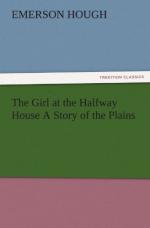“Hoping that you may receive this communication duly, and make reply to Same, and hoping above all things that I may soon meet again my Companion of the 47th., I beg to subscribe myself, my dear boy, ever your Obdt. & Affect. Friend,
“Battersleigh.
“P.S.—Pray Herild your advent by a letter & bring about 4 lbs. or 5 lbs. of your Favourite Tea, as I am Short of Same.”
The letter ended with Battersleigh’s best flourish. Franklin turned it over again and again in his hand and read it more than once as he pondered upon its message. “Dear old fellow,” he said; “he’s a good deal of a Don Quixote, but he never forgets a friend. Buffalo and Indians, railroads and hotels—it must at least be a land of contrasts!”
CHAPTER VI
EDWARD FRANKLIN, LAWYER
Edward Franklin had taken up his law studies in the office of Judge Bradley, the leading lawyer of the little village of Bloomsbury, where Franklin was born, and where he had spent most of his life previous to the time of his enlistment in the army. Judge Bradley was successful, as such matters go in such communities, and it was his open boast that he owed his success to himself and no one else. He had no faith in such mythical factors as circumstances in the battle of life. This is the common doctrine of all men who have arrived, and Judge Bradley had long since arrived, in so far as the possibilities of his surroundings would admit. His was the largest law library in the town. He had the most imposing offices—a suite of three rooms, with eke a shiny base-burner in the reception room. His was one of the three silk hats in the town.
Thirty-five years earlier, a raw youth from old Vermont, Hollis N. Bradley had walked into the embryonic settlement of Bloomsbury with a single law book under his arm, and naught but down upon his chin. He pleaded his first cause before a judge who rode circuit over a territory now divided into three Congressional districts. He won his first case, for his antagonist was even more ignorant than he. As civilization advanced, he defended fewer men for stealing hogs, and more for murder and adultery. His practice grew with the growth of the population of the country about him. He was elected county attorney, local counsel for the railroad, and judge of the circuit court. He was mentioned for gubernatorial honours, and would perhaps have received the party nomination but for the breaking out of the civil war. Not fancying the personal risks of the army, he hired a substitute, and this sealed his political fate; for Illinois at that time did not put in power men who sent substitutes to the war. None the less, the lands and moneys of the most prominent lawyer of the place kept him secure, and human memories are short; so that, when Edward Franklin and others of the young men of Bloomsbury returned from the war, they saw upon the streets of the little town, as they had seen before they went away, the tall form, the portly front, the smooth-shaven face, and the tall silk hat of Judge Hollis N. Bradley, who had in every sense survived the war.




